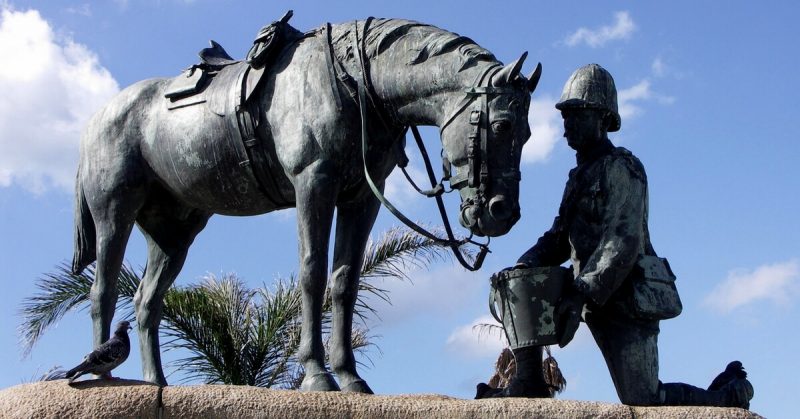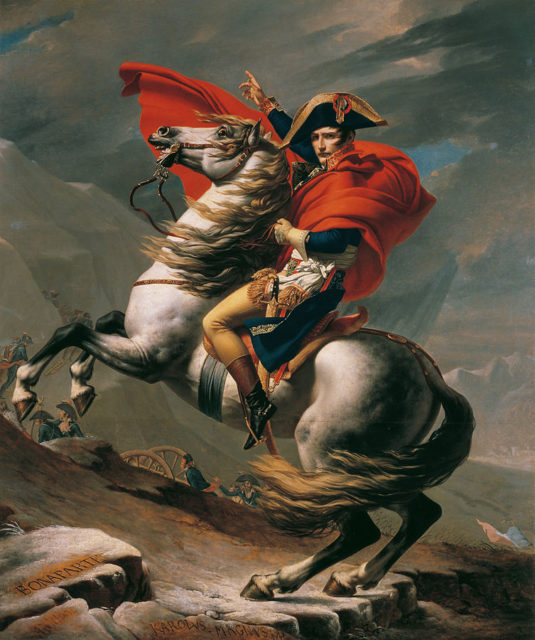Since mankind first learned to ride horses, we have been riding them into battle. Some war horses have been particularly beloved and famous, thanks to the bonds they shared with their riders.
Here are five of the most fondly remembered.
Bucephalus
The favorite steed of Alexander the Great, Bucephalus was believed to have been with the Macedonian monarch from the time Alexander was 12 or 13 years old. He won the horse in a bet with his father after taming the beast.
Bucephalus was a massive horse with one blue eye. His name meant “ox-head” and came from a mark branded on him.
Alexander rode Bucephalus in numerous battles. It is possible that Bucephalus may have died from wounds during the Battle of Hydaspes against King Porus of Paurava. Other accounts indicate he died of old age. Whatever the cause, Bucephalus died during Alexander’s campaign in the Punjab. In 326 BC, Alexander founded a city on the banks of the Hydaspes in his memory, naming it Bucephala.
Bucephalus became one of the most famous horses in classical culture, alongside such mythic beasts as Pegasus and the wooden Trojan horse. Due to his fame and the popularity of Alexander, it became a standard for other generals to make a show of having a favorite horse.
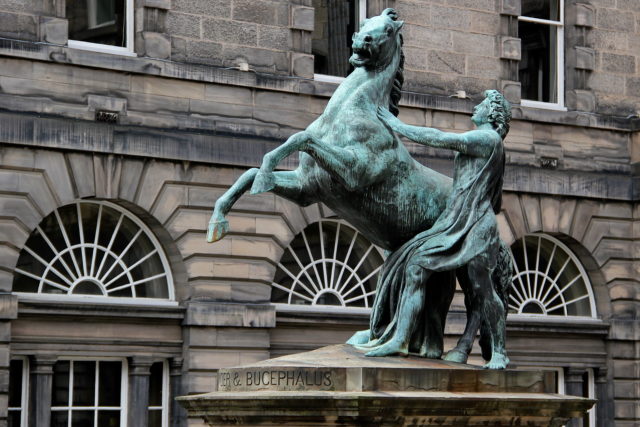
Marengo
Born around 1793, Marengo was a small gray Arabian stallion, only 145 cm high. Brought to France from Egypt in 1799, he became the steed of the First Consul and later Emperor of France, Napoleon Bonaparte.
Marengo was steady and brave, essential characteristics in a horse whose rider traveled the length and breadth of Europe making war. He carried the Emperor in battle at Austerlitz, Jena-Auerstedt, and Wagram. He was injured eight times in military service. During the Russian campaign of 1812, Marengo was one of 52 horses in Napoleon’s personal stud. He fled with the other horses during a Russian raid and survived the retreat from Moscow, unlike the majority of the soldiers in that unfortunate army.
When Napoleon returned to war during the Hundred Days, he once again rode his favorite horse. Marengo was captured at the Battle of Waterloo and sold to a captain in the British Grenadier Guards.
After Marengo died at the age of 38, his skeleton was put on display. It can still be seen at the National Army Museum in Chelsea. Two hooves were turned into souvenirs; one a snuff box, the other an inkwell.
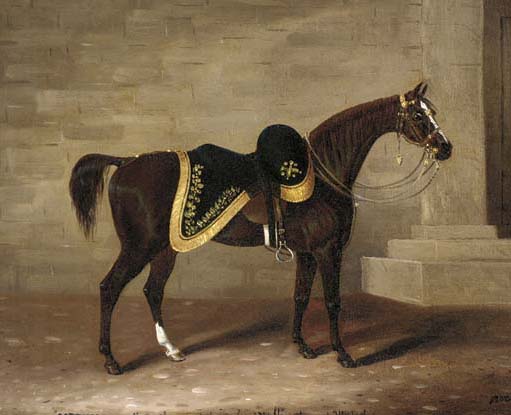
Copenhagen
Napoleon’s greatest opponent, the Duke of Wellington, had an equally famous horse.
Born in 1808, Copenhagen was a mixture of Arabian and Thoroughbred parentage. He was named in celebration of the British victory at the Second Battle of Copenhagen the year before his birth. Chestnut brown with two white heels, Copenhagen was compact, muscular, and powerful.
He did not start his career as a war horse. Instead, he raced in 1811 and 1812, coming in third each time.
Sold to Sir Charles Vane, he came to the Spanish Peninsula with Sir Charles in 1813. When Sir Charles left Spain, he sold Copenhagen to a colonel acting on behalf of the Duke of Wellington.
The Duke rode Copenhagen at several battles, most notably Waterloo, where he remained in the saddle constantly for 17 hours. On dismounting after his hand-earned victory, the Duke patted Copenhagen’s flank. The horse kicked out, narrowly missing Wellington’s head.
After the Napoleonic Wars, Wellington continued riding Copenhagen for ceremonies and parades. Copenhagen was retired to the Duke’s estates at Stratfield Saye. There he lived a relaxed and pampered life before dying at the age of 28. He was buried on the estate with full military honors in a funeral overseen by the Duke.
Years later, the Duke was asked if he would disinter Copenhagen’s skeleton for display with Marengo. He refused.
Palomo
Simón Bolívar’s campaigns of liberation carried him back and forth across Latin America for many years. During much of that time, he rode Palomo, his favorite horse.
Palomo was a beautiful horse and suited Bolívar who had a sense of drama with which he approached so much of life. Tall, white, and with a tail that reached almost to the ground, this was a horse that stood out amid the ramshackle armies of the wars of liberation.
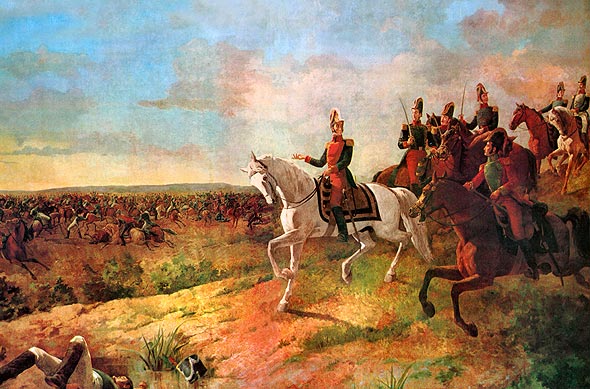
Palomo’s origins were supposedly far more humble. Gifted to Bolívar by an elderly peasant woman from Santa Rosa de Viterbo, in 1819, just before the Battle of Boyacá.
Palomo died while on a campaign. Having been loaned to one of Bolívar’s officers, the horse died of exhaustion during one of the long marches that featured in Bolívar’s wars. He was buried next to a hacienda chapel, and his horseshoes are now on display in the Museum of Mulaló.
Traveller
Born in 1857, Traveller was an American Saddlebred who started out with the name of Greenbrier, after his home county in Virginia. 163 cm high and weighing 500 kg, he was a tough, sturdy horse. He had iron gray hair with black points and a long mane and tail.
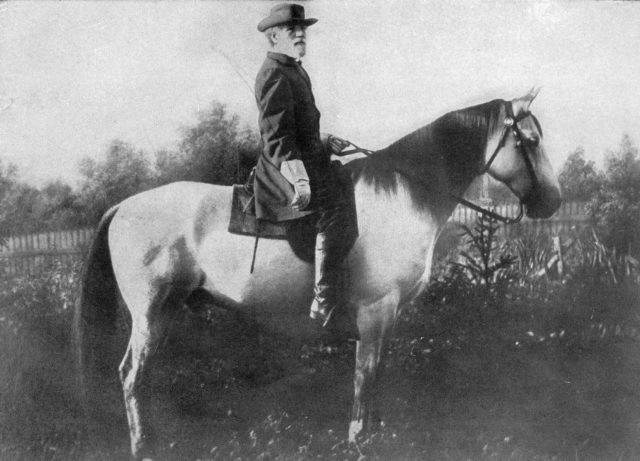
In February 1862, General Robert E. Lee bought Greenbrier for $200 and renamed him, Traveller, using the British spelling with two “L”s. Lee was very proud of the horse, all the more so because of his color, which he described as Confederate gray.
Lee rode Traveller during many of his battles commanding Confederate forces during the American Civil War. At the Second Battle of Bull Run, Lee was holding Traveller by the bridle when the horse spooked pulling Lee down onto a stump. Both the General’s hands were broken, and for some time he had to travel in an ambulance.
During Lee’s funeral procession in 1870, Traveller followed the casket, with black crepe draped over his saddle and bridle. A year later, he stepped on a nail, developed tetanus, and was shot to put him out of his suffering.
